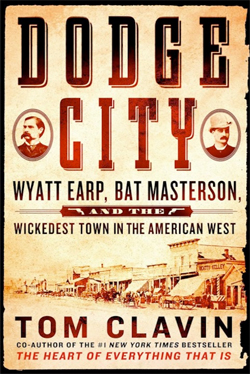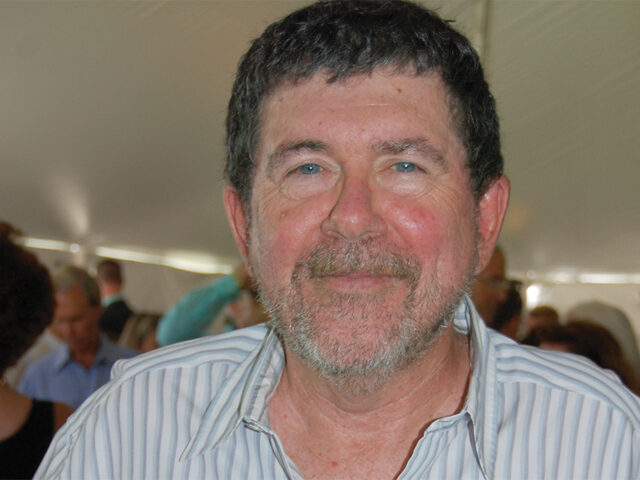 Tom Clavin and longtime co-author Bob Drury dug deep into Lakota Chief Red Cloud’s life and times in their 2013 book The Heart of Everything That Is. For his recent solo effort, Dodge City: Wyatt Earp, Bat Masterson and the Wickedest Town in the American West, Clavin first plumbed the Dodge City exploits of Bat Masterson before expanding his scope to others with ties to that Kansas cow town, including the Earp brothers, Masterson’s own brothers, Wild Bill Hickok and Theodore Roosevelt. Clavin recently spoke with Wild West about Red Cloud, the interconnections between Bat Masterson and Wyatt Earp, the lawmen’s time in Dodge City and more about his new book.
Tom Clavin and longtime co-author Bob Drury dug deep into Lakota Chief Red Cloud’s life and times in their 2013 book The Heart of Everything That Is. For his recent solo effort, Dodge City: Wyatt Earp, Bat Masterson and the Wickedest Town in the American West, Clavin first plumbed the Dodge City exploits of Bat Masterson before expanding his scope to others with ties to that Kansas cow town, including the Earp brothers, Masterson’s own brothers, Wild Bill Hickok and Theodore Roosevelt. Clavin recently spoke with Wild West about Red Cloud, the interconnections between Bat Masterson and Wyatt Earp, the lawmen’s time in Dodge City and more about his new book.
In past you’ve interviewed participants in historical events. How did you change your research techniques to cover Red Cloud, Wyatt Earp and Bat Masterson?
Searching for original sources in archives replaced searching for people to interview. With The Heart of Everything That Is the research focused on materials in libraries and other repositories in Wyoming, South Dakota, and Nebraska written by Army officers, officers’ wives, teamsters, travelers—whoever wrote about their experiences on the Plains in the mid-1800s. With Dodge City a big help were the Kansas Historical Society, Kansas Heritage Center and the archives of the Dodge City Times and Ford County Globe.
In The Heart of Everything That Is you relate much of Red Cloud’s story in his own words. How important was that for you?
Very important, for two reasons: One was to have his particular point of view, and the other is to have any writing about 1800s events from an Indian perspective. As other researchers of the American West know, it is rare to find reliable material written by Indians, which can result in their experiences not being given full expression in an article or book.
Dodge City was the intersection of so many people exploring the American frontier, including rowdy cowboys and men bent on no good. It certainly was a place to build one’s reputation, if you had the sand to do it.
Was Red Cloud born to be a great warrior?
Most likely. His father hoped for that, as that role would be the most favored among the Oglala Sioux. But his father died of alcoholism when Red Cloud was only 5, meaning he had to overcome stiffer odds to become a warrior. Being as good as the others was not enough; he had to be better.
In what ways did Red Cloud unite not only the Lakotas, but also other tribes in resisting U.S. military incursion into the Powder River Basin?
This ability to unite rival tribes and factions is what makes Red Could unique in American history. In addition to such disadvantages as inferior weapons and no immunity to certain diseases, Plains Indians were more interested in warring among themselves than in uniting against a common foe. The force of Red Cloud’s personality and the broad respect accorded him as a warrior, tactician and leader, plus the allegiance of young, charismatic warriors like Crazy Horse, resulted in other tribes and bands sharing his vision of protecting the Black Hills and resisting this huge threat to the entire Indian way of life.
How did the Army respond to the disastrous December 1866 Fetterman Fight?
Once you wipe out an entire U.S. Army force, there is no going back. Either way, there would be a dramatic response—an attack on Red Cloud’s coalition by a larger force or the federal government sues for peace for the first time to an Indian tribe. Washington chose the latter, and the resulting Treaty of 1868 was perhaps the most pro-Indian one created—and for six years it was upheld.
How did Red Cloud’s successes contribute to the rise of Crazy Horse?
Not only did Crazy Horse play a crucial role as Red Cloud’s field general, but also for once he was on the winning side. He became something of a legendary figure while in his mid-20s. Eventually, he moved on to riding with Sitting Bull, after Red Cloud ceased to be a military leader.
Why turn to Dodge City?
My initial interest was Bat Masterson. His name earns immediate recognition, but not a lot is known about him, and in the movies, for example, if he is portrayed at all, it is often as a buffoonish second banana. But as my research progressed, I became more intrigued by his friendship with Wyatt Earp and their early years as lawmen in Dodge City. My focus began to sharpen on that place and time and Wyatt’s and Bat’s exploits there.
How did you discern legend and lore from fact?
I compare it to being a gold prospector—sift through what’s in the pan, and maybe, if you’re lucky, at the end of the day you have a valuable nugget or two. Dodge City took three years of work because of that laborious process. What I thought was solid, authentic material at the end was a lot different from when I began. What was a delightful relief was to learn that what was true, or at least likely true, was as enjoyable, if not more so, than the fabrications and embellishments.
How did the women in each man’s life alter his path? For example, would Wyatt’s life have been different had his first wife not died of illness?
The death of Wyatt’s first wife when he was in his early 20s changed his path. He may have been content to spend the rest of his life raising a family in Lamar, Mo., but Aurilla’s tragic death sent him on a downward spiral that led him to Ellsworth, Wichita and then Dodge City. After that I don’t think Wyatt’s three “wives” changed him much; he and his brothers did what they wanted to do. Bat also had a woman he loved die on him, and it was many years before he married. Bat was devoted to Emma, and she seemed willing to go on whatever path he chose to ride.
Did men like the Earps, Masterson and Bill Tilghman become iconic characters because of the attention they received in Dodge City? Or did the city itself give them the opportunities to build their reputations?
I think these men of strong character and personal courage—add Charlie Bassett to the mix—would have distinguished themselves in any frontier town. But what an opportunity the “wickedest town in the West” offered! It was the intersection of so many people exploring the American frontier, including rowdy cowboys and men bent on no good. It certainly was a place to build one’s reputation, if you had the sand to do it.
How does Masterson’s story stack up to Earp’s?
To me, pound for pound, Bat had the more adventurous life, and he lived it fully to the day he died. But he did not have that one major iconic event like the Gunfight at the OK Corral that became the stuff of mythmaking. I am hoping a pleasant surprise for readers is to discover Bat Masterson and his role in civilizing the American West.
In what way did sports draw Masterson in new directions?
It was an important reason why his travels went beyond Kansas, then Colorado, then elsewhere. He loved boxing and he came to love baseball. With boxing, he was sometimes a spectator, sometimes a referee at important bouts. When he was a New York newspaper columnist, sports were often a topic, and he crusaded to get the criminal element out of boxing.
What led him to journalism?
Unlike Wyatt, Bat enjoyed expressing himself. He wrote letters—one of his regular correspondents was Frank James—and then reminiscences about his early days on the frontier, including Dodge City. When he and Emma were in New York, he was offered a job with The Morning Telegraph, and he was happy to take it. The last 15 or so years of his life as a journalist and Broadway bon vivant were very happy ones for Bat. And what better way for a newspaperman to go than to die at your desk after typing “—30—”?
What’s next for you?
The tentative title of my next book is Valley Forge: George Washington and the Rescue of the American Revolution. I’m writing it with Bob Drury, and we hope it will be embraced by readers. I am enormously fortunate to do solo projects like Dodge City and also ones with a collaborator who is one of my best friends.





